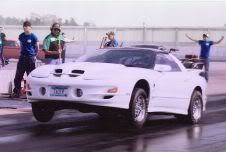Anybody have any real world numbers or results out there. I know the Lobe is quite new but it seems like everyone is secretive about them?? I have switched to a new LSL lobe in my all motor 441 and love it. The driveability is a ton better with gobs more torque on the bottom end. Lost about 10 rwhp up top from my last cam but it just seems alot funner to drive!. I did take it to the track but had alot of issues. The difference was i went from a 10.46 to a 10.50 in the 1/4 but my 60ft went from a 1.49 to a 1.42? I know, different track different day right. Anyone else have some real world results?
Announcement
Collapse
No announcement yet.
Comp LSL Lobe Discussion
Collapse
X
-
-
LSA will change the timing of your intake valve closing which in turn changes your cranking compression by how much volume is trapped at low speeds. This all changes your torque output up to 4,000rpms. Advancing and retarding the cam will produce simular effects.
An engine with heads that dont breath well enough will benefit noticably using a cam with a narrower LSA. Check out how wide the LSA's are on a pro stock head.
Comment
-
Also bigger engines can get away with wider LSA's and that's the main reason pro stock engines use them, Could it also be that they spin to 9K? and breath better too.Originally posted by big block fiero View PostLSA will change the timing of your intake valve closing which in turn changes your cranking compression by how much volume is trapped at low speeds. This all changes your torque output up to 4,000rpms. Advancing and retarding the cam will produce simular effects.
An engine with heads that dont breath well enough will benefit noticably using a cam with a narrower LSA. Check out how wide the LSA's are on a pro stock head.
Comment
-
Where we are now at with this topic gets confusing and is where for me I flip the discussion to that of, how much overlap scavenging do he need for a given application.
Just the criterea of running open headers means that the overlap scavenging FLOW will be so improved that the heads will over scavenge and so less overlap (wider lobe sepparation) will prevent this and make more power.
Secoundly, any engine running 9,000rpm's will of course, require more valve lift/duration which will consequently increase the valve overlap degrees (assuming no cam LSA changes). Widening the lobe centers over this issue is mearly to restore the overlap degrees to that simular of a compared, smaller camed, engine. I over simplified this on purpose over these bigger issues, there's more to it but this description serves well.
thirdly, yes, prostocks breath well = wider LSA to prevent overscavenging via less overlap.
a boosted engine overscavenges during overlap so of course a wider LSA is required within a given rpm comparison.
please dont be offended by my overzelous discussion, i'm just trying to liven up the board.
Comment
-
Originally posted by big block fiero View PostWhere we are now at with this topic gets confusing and is where for me I flip the discussion to that of, how much overlap scavenging do he need for a given application.
Just the criterea of running open headers means that the overlap scavenging FLOW will be so improved that the heads will over scavenge and so less overlap (wider lobe sepparation) will prevent this and make more power.
Secoundly, any engine running 9,000rpm's will of course, require more valve lift/duration which will consequently increase the valve overlap degrees (assuming no cam LSA changes). Widening the lobe centers over this issue is mearly to restore the overlap degrees to that simular of a compared, smaller camed, engine. I over simplified this on purpose over these bigger issues, there's more to it but this description serves well.
thirdly, yes, prostocks breath well = wider LSA to prevent overscavenging via less overlap.
a boosted engine overscavenges during overlap so of course a wider LSA is required within a given rpm comparison.
please dont be offended by my overzelous discussion, i'm just trying to liven up the board.
No problem Matt, always nice to have you post here.
Comment
 2001 Trans Am All Motor 9.75 @139mph
2001 Trans Am All Motor 9.75 @139mph


Comment